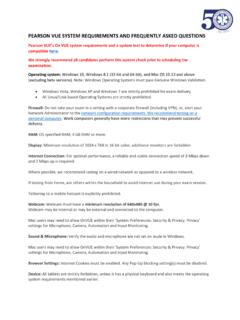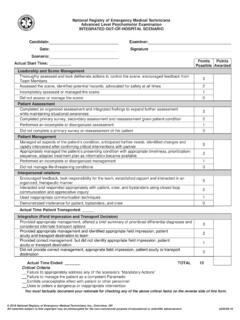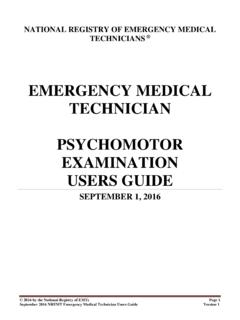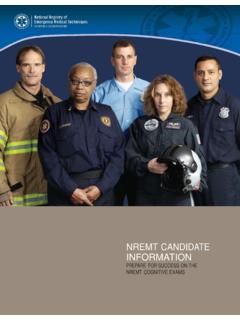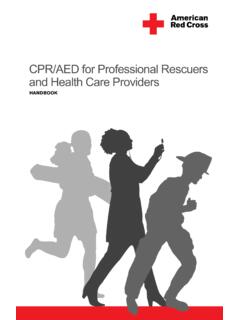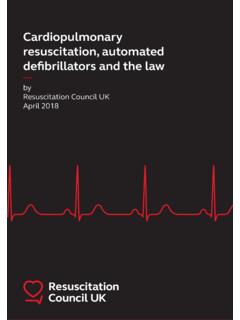Transcription of (Dynamic Cardiology, Static Cardiology, and Cardiac Arrest ...
1 Cardiac Management (Dynamic Cardiology, Static Cardiology, and Cardiac Arrest Management/AED). Instructions to Skill Examiners Thank you for serving as a Skill Examiner at today's examination. Before you read the instructions for the skill you will be evaluating today, please take a few moments to review your general responsibilities as a Skill Examiner: Conducting examination-related activities on an equal basis for all candidates, paying particular attention to eliminate actual or perceived discrimination based on race, color, national origin, religion, gender, age, disability, position within the local EMS system, or any other potential discriminating factors.
2 The Skill Examiner must help ensure that the EMT Assistant and/or Simulated Patient conduct himself/herself in a similar manner throughout the examination. Objectively observing and recording each candidate's performance Acting in a professional, unbiased, non-discriminating manner, being cautious to avoid any perceived harassment of any candidate Providing consistent and specific instructions to each candidate by reading the Instructions to the Psychomotor Skills Candidate exactly as printed in the material provided by the National Registry.
3 Skill Examiners must limit conversation with candidates to the communication of instructions and answering of questions. All Skill Examiners must avoid social conversation with candidates or making comments on a candidate's performance. Recording, totaling, and documenting all performances as required on all skill evaluation forms Thoroughly reading the instructions for the assigned skill before actual evaluation begins Checking all equipment, props, and moulage prior to and during the examination Briefing any Simulated Patient and EMT Assistant for the assigned skill Assuring professional conduct of all personnel involved with the particular skill throughout the examination Maintaining the security of all issued examination material during the examination and ensuring the return of all material to the National Registry Representative Both Intermediate/99 and Paramedic candidates complete both Dynamic and Static Cardiology Skills.
4 Therefore, you should ask the candidate at which level he/she is testing and record the level on the evaluation sheet by checking the appropriate block on the evaluation form. Be sure to stop the scenario at the appropriate point for Intermediate/99 candidates so that you are not evaluating them to a standard outside the scope of his/her education. Advanced Emergency Medical Technician (AEMT) candidates only complete the Cardiac Arrest Management/AED portion of these skills. These skills are designed to verify a candidate's competence in recognition and treatment of Cardiac arrhythmias in accordance Emergency Cardiovascular Care (ECC) guidelines for Advanced Cardiac Life Support.
5 There are two separate and distinct parts tested in different manners, namely a dynamic, scenario-based portion and a Static portion. Either of these two parts may be presented first. You should read the specific instructions for each portion just prior to evaluation of that portion. If multiple Cardiac Management Skills are set-up and divided into separate Dynamic and Static portions, you must help ensure that each candidate is evaluated over the material from the same testing scenario in both parts. For example, a candidate who completes the Dynamic Cardiology portion using Set #1006 testing materials must complete the Static Cardiology portion using Set #1006 testing materials as well.
6 2019 by the National Registry of EMTs Page 1 of 7. Dynamic Cardiology The dynamic portion evaluates the candidate's ability to deliver sequential care given prepared patient presentations, including proper setup and use of the manual ECG monitor and defibrillator (no automated, semi-automated or interpreting machines permitted). In this portion, the candidate will be evaluated utilizing a defibrillation manikin and ECG monitor/defibrillator. The manikin must be placed and left on the floor for this skill.
7 Each candidate must physically demonstrate and actually perform all electrical interventions necessary. Prepared dynamic sequences will be provided; each candidate must be evaluated over one complete sequence. Each scenario contains four separate and sequential arrhythmias that must be presented in order and treated in accordance with the Suggested Interventions as noted in the scenario. You are not permitted to alter any arrhythmia or sequence as outlined. Several important aspects of this evaluation format must be clarified.
8 The progression of arrhythmias in all scenarios must be strictly followed. The progression of this skill is quite similar to a "megacode." However, you may not include additional arrhythmias, drugs, or introduce any problem-solving situations. Each candidate must "voice" his/her interpretation of each arrhythmia as well as all treatments and interventions (medications, IVs, intubation, etc.) he/she would provide for the patient. You will need to develop a dialogue with each candidate and should ask questions for clarification purposes.
9 For example, if a candidate states, "I'd give a dose of atropine," you should ask him/her to explain how much atropine he/she would administer and by what route. You must also acknowledge that the treatments or interventions have been completed without difficulty immediately after the order has been given. If a candidate calls for, performs, or administers an inappropriate treatment or intervention at a point where the arrhythmia is to change, you must change to the next arrhythmia listed in the scenario even if a real patient would convert to some other arrhythmia or respond in another fashion.
10 It is important to remember that the patient's response in these prepared scenarios is not indicative of the appropriateness of a candidate's interpretations and/or treatments. Be sure to emphasize this point in the instructions to each candidate. Any incorrect or inappropriate interpretation, treatment, or intervention must be documented in the space provided on the evaluation form. Safety is an important consideration in this skill. Either hands-on or hands-off delivery of shocks is acceptable. However, live shocks must be delivered by each candidate for verification purposes.



